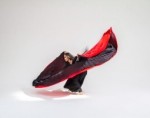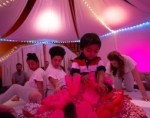
In A Time Warp Called Reality, Theatre in the X Travels to the Museum
by Jenna Horton
In a quest to reach new audiences for performing arts in Philadelphia, Theatre Philadelphia and thINKingDANCE are joining forces and exploring how dance writing and discourse can provide new perspectives on theater. Beginning May 2018, tD writers have been lending their varied backgrounds, interests, and approaches to criticism to professional works of theater in Philadelphia. Let us know what you think in the comments!
“People kept asking for a 'black' play. I kept asking, 'What's a “black” play. Four walls, a couch and a mama?' I can't exist within those old definitions.”
—George C. Wolfe, from a New York Times article by Jeremy Gerard, Nov. 6, 1986
I’ve been handed a boarding pass, Cabin A, operated by Celebrity Slaveship, headed from the Gold Coast to Bahia, Port-au-Prince, and Havana, with a final stop in Savannah. The pass doubles as my program for George C. Wolfe’s The Colored Museum, first produced in 1986, and now co-produced by Theatre in the X in partnership with the African American Museum in Philadelphia (AAMP) as part of Theatre Philadelphia’s Theatre Week in 2019.
By staging The Colored Museum in the African American Museum, Theatre in the X departs from its geographical home, Malcolm X Park in West Philadelphia, but otherwise maintains the integrity of its mission. Founded by Walter DeShields, LaNeshe Miller-White and Carlo Campbell in 2013, the company aims “to provide the people of West Philadelphia and the African American community at large the opportunity to see professional quality theater in their own neighborhood for no cost.”
We stand, waiting, in AAMP’s actual exhibit hall displaying the timeline entitled “Audacious Freedom: African-Americans in Philadelphia 1776-1876,” when “Git On Board,” the first exhibit of Wolfe’s fictional Colored Museum cuts through the space. Nastassja Baset plays Miss Pat, a perky flight attendant, who flashes us a gleaming service smile. She points at the “fasten your shackles” sign, pulls heavy prop shackles from under a museum plaque where they are described, and requests no drumming and no rebelling. We’re experiencing a little time warp. “On your right you will see the American Revolution, which will give the U.S. of A. exclusive rights to your life. And on your left, the Civil War, which means you will vote Republican until F.D.R. comes along. And now we’re passing over the Great Depression, which means everybody gets to live the way you’ve been living.” This is the clip at which The Colored Museum moves across pain.
In this past-present-potential-future time, passengers carry different baggage. Mine is made from cotton and an invention called whiteness, through which I see, hear, and breathe. The flight to avoid confronting a white legacy of enforcing and upholding structural racism, trauma, and harm is boarding from gate B 11, Terminal C and has been sold out for 400 years. Meanwhile, I stuff my unorganized baggage labeled ‘fragile’ in the overhead compartment (stowed, not gone) and hope it doesn’t fall out and hit someone in the head, or inflate and take up the whole goddamn plane. This play-ne has arrived to chart a different course: how do African-Americans live with and confront their own legacy, pain and joy, inflicted stereotypes and erasure, reflections and refractions?
The caricatures in The Colored Museum answer. The voices are multiple (as are the live responses), ranging from the schizophrenic to the outright vivacious. Miss Roj (played dynamically by Derek Deleqúa) flaunting pink cat-eye glasses and white go-go boots, on working a bar called “The Bottomless Pit”: “Yeah, snap your fingers and dance with Miss Roj. But don’t be fooled by the banners or balloons ‘cause, child, this ain’t no party goin’ on. Hell no! It’s a wake.” An Afro wig named Janine (LaNeshe Miller-White): “When you wearin’ me, you lettin’ him know he ain’t gonna get no sweet-talkin’ comb through your love without some serious resistance. No-no! The kink of my head is like the kink of your heart and neither is about to be hot-pressed into surrender.” The cast soars in one of Wolfe’s more complete sketches, “The Last Mama on the Couch Play,” and makes it sing and zing, roasts and all.
These and other voices reach out from Wolfe’s 11 exhibits or sketches of African-American stereotypes put on display for public consumption, back-to-back, black to black. Wolfe says he wrote The Colored Museum in order to “undefine myself in relation to all of those labels,” labels which the performers take on. They don, perform, and strut within the roles, which beg the questions: am I a useful mirror, do you want to throw me away, and can you even? The provocation of satire hovers: whether wearing the definition recapitulates or releases, not to mention for WHOM and WHY.
Director DeShields ditches the revolving white walls called for in the original script and implants Wolfe’s fictional museum directly inside an actual museum (admittedly, with its own walls and labels). But contrary to the predominantly white-washed history told on the nearby Independence Mall (or Field of Amnesia), and contrary to the predominantly white audiences of capital T Theatre (not to mention its reviewers), this play space brings ‘black’ into question and multiplicity, even if by fracture and fire.
Is Wolfe’s exorcism party relevant in 2019?
Is it relevant we’re here at the African American Museum, just off National Park grounds, where white father’s stories still rule?
Is it relevant we’re two blocks away from where the Avenging the Ancestors Coalition fought for the historical interpretation of slavery at the President’s House in the early 2000s?
Is it relevant we’re near where Ona Judge walked, where Hercules took his evening strolls, and where Richard Allen set up the first African American mutual aid society?
Is it relevant there’s “only one month for Black History”?
Is it relevant I view this from a flight called white?
The Colored Museum, Theatre in the X, African American Museum, February 16 & 17
To join the conversation, follow thINKingDANCE and Theatre Philadelphia online and on social media to read, share, and comment.
By Jenna Horton
February 22, 2019










